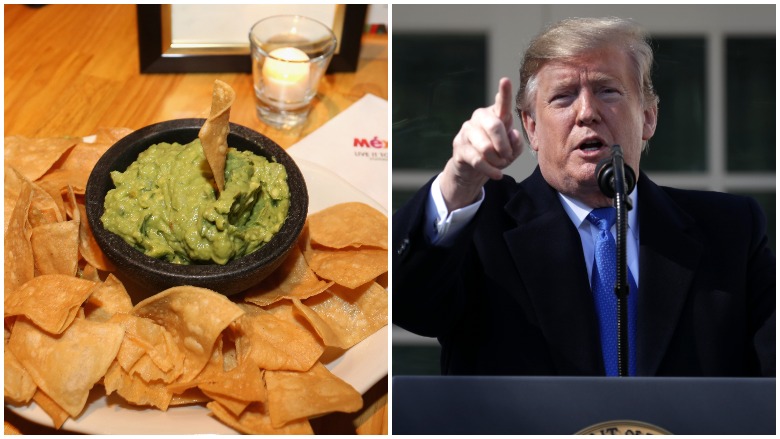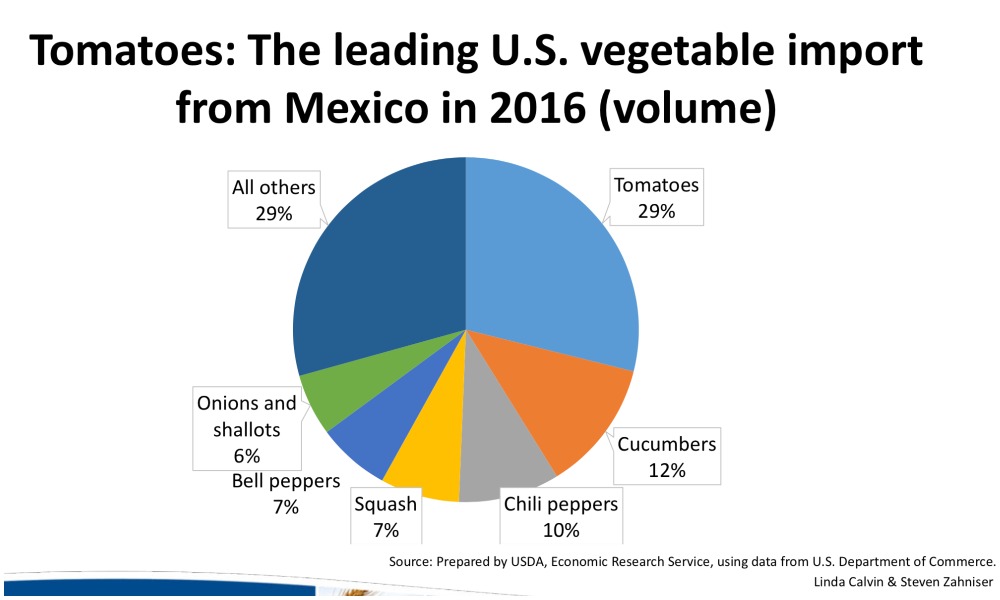
Getty
President Trump has threatened to close the border with Mexico, which means shutting down legal ports of entry that are used to transport hundreds of billions of dollars worth of goods between the two nations each year.
American families would feel the impact almost immediately at the grocery store. Nearly half of the fruits and vegetables imported into the United States come from Mexico, according to the Department of Agriculture.
One of the items Americans would potentially have to say goodbye to in the meantime would be avocadoes. The president of Mission Produce, Steve Barnard, told Reuters that the United States would run out of avocados within three weeks of sealing border because Mexico “supplies virtually 100 percent of the avocados in the U.S. right now.”
President Trump is scheduled to visit the border in Calexico, California, on Friday, April 5.
Here’s what you need to know.
1. The U.S. Imports Billions of Dollars Worth of Fruit, Vegetables & Beer From Mexico Each Year

U.S. Department of Agriculture
Mexico is the third-largest trading partner of the United States, behind China and Canada. In 2017, $615 billion worth of goods and services were exchanged between the two countries, according to the Office of the United States Trade Representative, which is part of the executive branch.
U.S. agricultural imports from Mexico represented $24.6 billion. According to the Department of Agriculture, about 70 percent of the agricultural items imported from Mexico consist of beer, vegetables, and fruit.
By comparison, Mexico purchased $18.6 billion worth of agricultural products from the United States in 2017. The top exports included livestock and other animal products, corn, grains, and soybeans.
2. The U.S. Relies Heavily on Mexico For Avocados Because The Fruit Can Be Grown Year-Round There

The avocado is native to south-central Mexico. Historians say avocados were growing in the region as far back as 7,000 B.C. The crop was introduced to Florida and California during the 1800s. But the United States still relies on Mexico for the majority of its avocados because the fruit grows year-round in Mexico. Avocados are a seasonal crop in California.
The avocado growing season in California lasts from February to September. Harvests typically pick up during the spring. As Steve Barnard from Mission Produce explained to Reuters, sealing the Mexican border now would mean a sudden drop in avocado supply. “California is just starting and they have a very small crop, but they’re not relevant right now and won’t be for another month or so.”
The Department of Agriculture says that avocados account for a full 10 percent of the agricultural items the United States imports from Mexico. It’s estimated that Americans eat more than 4 billion avocados each year.
3. Americans Rely Primarily on Mexico for Other Produce Such as Cucumbers, Tomatoes & Raspberries

In addition to avocados and that side of guacamole, consumers may also need to be prepared to go without items like tomatoes and cucumbers or pay a higher price for them. Reuters reported that Mexico supplies 44 percent of the produce eaten in the United States.
The U.S. relies on Mexico for tomatoes nearly as much as we do avocados. Tomatoes account for 8 percent of the total agricultural items imported from Mexico.
Mexico also supplies a majority of cucumbers, raspberries, and blackberries. The Department of Agriculture released a study in 2017 listing the top vegetables imported from Mexico by volume. The study found that tomatoes accounted for 29 percent of imported vegetables. Cucumbers accounted for 12 percent, chili peppers 10 percent, and squash and bell peppers at 7 percent each. You can read the full report here.
4. President Trump Called on Mexico to Stop Illegal Immigrants From Entering the United States & Threatened to Seal the Border
President Trump has threatened to seal the legal ports of entry with Mexico over illegal immigration. The threat comes on the heels of a report from U.S. Customs and Border Protection, which found that the total number of illegal crossings had increased. Family units made up a substantial percentage of those entering the United States. Border Patrol says agents apprehended 66,450 people in February, up from 47,986 in January.
President Trump has told reporters and stated on social media that he feels Mexico needs to do more to stop people from crossing into the United States. He tweeted on March 29, “The DEMOCRATS have given us the weakest immigration laws anywhere in the World. Mexico has the strongest, & they make more than $100 Billion a year on the U.S. Therefore, CONGRESS MUST CHANGE OUR WEAK IMMIGRATION LAWS NOW, & Mexico must stop illegals from entering the U.S……..through their country and our Southern Border. Mexico has for many years made a fortune off of the U.S., far greater than Border Costs. If Mexico doesn’t immediately stop ALL illegal immigration coming into the United States throug our Southern Border, I will be CLOSING……..the Border, or large sections of the Border, next week. This would be so easy for Mexico to do, but they just take our money and “talk.” Besides, we lose so much money with them, especially when you add in drug trafficking etc.), that the Border closing would be a good thing!”
Kevin Hassett, the chairman of the Council of Economic Advisers, told reporters on April 1 that officials at the White House were “looking into and studying” the potential economic impact of closing legal ports of entry at the border.
5. U.S. Businesses Could Expect Immediate Financial Losses Due to the Inability to Export Product to Mexico
As referenced above, Mexico is one of the most important trade partners for the United States. According to the Office of the United States Trade Representative, which is part of the executive branch, nearly 16 percent of all goods & services exported from the United States in 2017 went to Mexico. For example, an estimated 37 percent of motor vehicle parts and 35 percent of engine parts manufactured in the United States are exported to Mexico.
The top export categories were listed on the government website as:
• Machinery ($43 billion)
• Electrical machinery ($41 billion)
• Mineral fuels ($27 billion)
• Vehicles ($21 billion)
• Plastics ($17 billion)
The U.S. borders have been closed before, but it’s a rare occurrence. President Bush partially sealed the Mexican border after the September 11th attacks. President Reagan briefly closed the border in 1985 after a DEA agent was killed in Mexico. President Johnson temporarily closed entry points after the assassination of John F. Kennedy.